Pesticide usage: outdoor vegetable crops 2019
Information from a survey of pesticide use on outdoor vegetable crops grown in Scotland during 2019.
This document is part of a collection
General trends
Crop area
In 2019 the census area of outdoor vegetable crops grown in Scotland was 18,624 hectares (Table 20). This represents a four per cent reduction in cropped area from 2017(3) and a 12 per cent increase from 2015(4). Since the last survey, census areas of all vegetable crops have decreased with the exception of vining peas, broad beans, leeks and lettuce (Figure 1). The largest reductions were seen in cabbages (18 per cent), calabrese (17 per cent), carrots and Brussels sprouts (both 11 per cent) (Table 20).
In 2019 peas and beans accounted for 53 per cent of the outdoor vegetable crop area, carrots 18 per cent, leaf brassicas 16 per cent, turnips and swedes eight per cent and other vegetables five per cent (Figure 2).
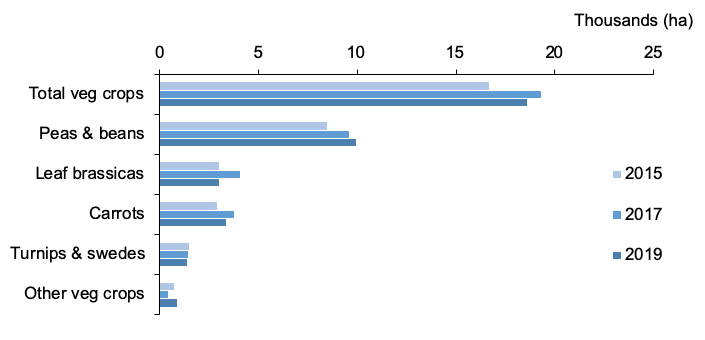
Note: areas do not include multi-cropping
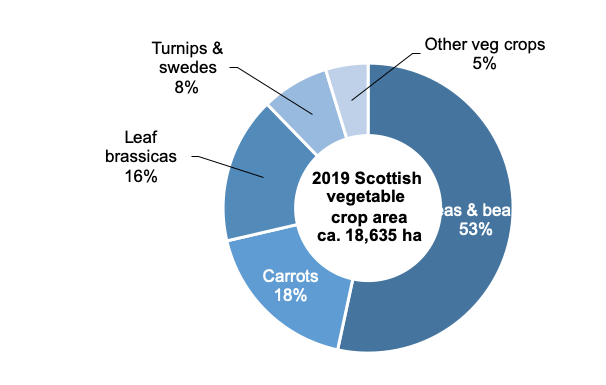
Note: areas include multi-cropping
Pesticide usage
In 2019, 96 per cent of vegetable crops received a pesticide treatment, a slight increase from the 2017 figure of 93 per cent and a decrease from the 2015 figure of 98 per cent. The crops receiving the highest overall treatments proportionally were vining peas, broad beans, Brussels sprouts, calabrese and turnips and swede (96 to 100 per cent, Table 1). Carrots, other brassica crops and other vegetable crops had the lowest proportion of treated crop (87, 84 and 84 per cent treated respectively). The treated area of crops received on average 5.3 sprays compared to 5.4 sprays in 2017 and 5.8 in 2015. The highest average number of spray applications were to Brussels sprouts with 18.5 sprays. The lowest number of sprays, as in 2017, were to vining peas at 2.2 sprays on average (Table 1).
The estimated area of outdoor vegetables treated with a pesticide formulation was 176,200 in 2019 compared with ca. 170,900 hectares in 2017 and ca. 179,000 in 2015 (Table 19, Figure 3). This represents an increase of three per cent since 2017 and a decrease of two per cent since 2015.
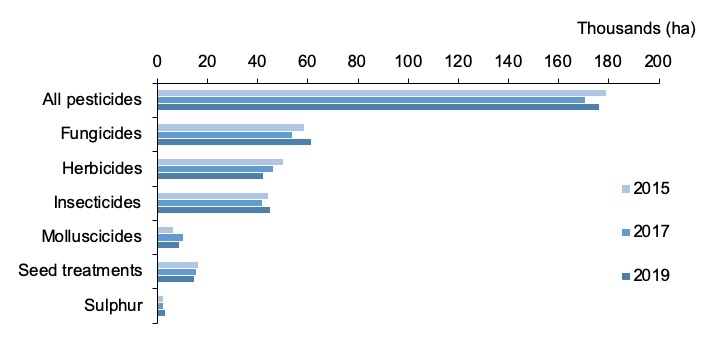
Note: growth regulators, biological control, biopesticides and physical control have all been excluded as their use represents <500 hectares
The weight of pesticide applied was ca. 72.6 tonnes in 2019, an increase of 11 per cent from 2017 (ca. 65.6 tonnes) and an increase of 8 per cent from 2015 (ca. 67.3 tonnes) (Figure 4).
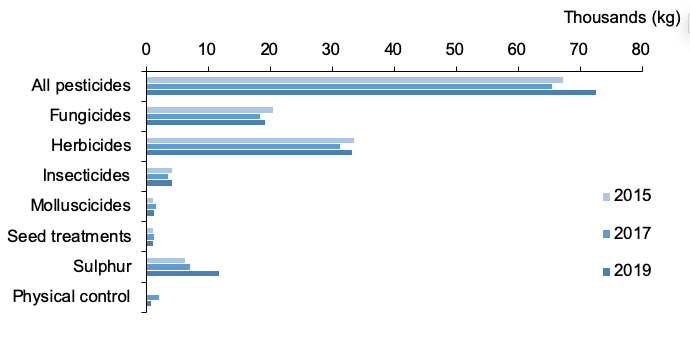
Note: biopesticides and growth regulators have been excluded as their use represents <700 kg. Invertebrate biological control agents are applied by number of organisms rather than weight therefore weight data are not presented
In order to make accurate comparisons between the 2019 data and that reported in previous surveys, it is important to take into account differences in crop areas between years. Therefore, the number of treated hectares per hectare of crop grown and the total weight of pesticide used per hectare of crop grown were calculated. In 2019, for each hectare of crop grown, almost 9.5 pesticide treated hectares were recorded (Figure 5). This represents an increase of seven per cent when compared to 2017 but a reduction of 12 per cent from 2015. The estimated weight of pesticide applied per hectare of crop grown in 2019 was slightly below four kilograms (Figure 6). This represents an increase of 15 per cent from 2017 and a decrease of four per cent from 2015. There was a reduction in overall pesticide use in 2017 influenced by the climatic conditions that year, leading to a lower pest pressure(3). Therefore, although pesticide use in 2019 is greater than reported in 2017, overall it is lower than encountered in 2015.
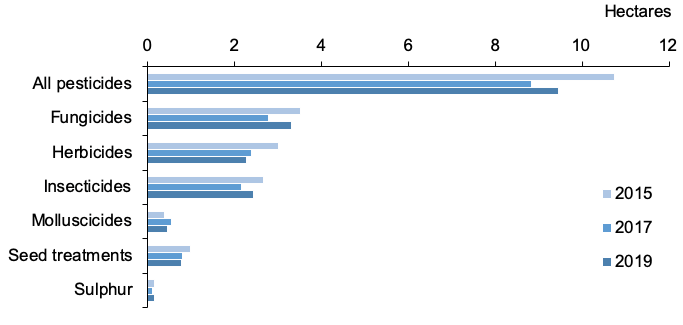
Note: growth regulators, biological control, biopesticides and physical control have been excluded as their use represents <0.1 treated hectares per hectare of crop grown
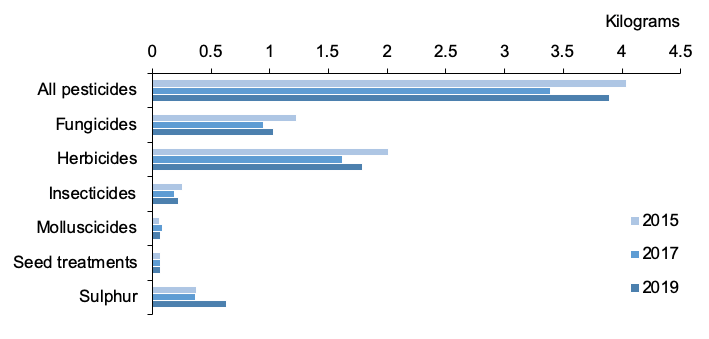
Note: growth regulators, biopesticides and physical control agents have been excluded as their use represents <0.1 kg per hectare of crop grown. Invertebrate biological control agents are applied by number of organisms rather than weight therefore weight data are not presented
As in 2017, fungicides were the most frequently used pesticides, by area treated, on outdoor vegetable crops (Figure 7). They were followed by insecticides and herbicides. Fungicides accounted for 35 per cent of total pesticide treated area and 26 per cent of the total weight of pesticides applied (Figures 7 & 8). When changes in crop area are taken into account, the area treated with fungicides increased by 19 per cent from 2017 to 2019 but has decreased by six per cent between 2015 and 2019 (Figure 5). From 2017 to 2019, there was an increase of nine per cent in the weight of fungicides used per hectare of crop grown, but a decrease of 16 per cent between 2015 and 2019 (Figure 6). The decreased use of fungicides in 2017 compared to 2015 and 2019 may have been influenced by the weather. There was 63 per cent more rainfall recorded in spring 2015 than in spring 2017 and 77 per cent more rainfall in spring 2019 than in spring 2017 in the East of Scotland where the majority of vegetable crops are grown(5). The drier spring may have helped to reduce disease pressure on crops in 2017(3). The principal fungicide mode of action on vegetable crops continues to be inhibition of respiration (this group includes strobilurins and SDHIs, Table 15). The use of fungicides with this mode of action increased by 22 per cent when compared to the previous survey in 2017.
In 2019, herbicides accounted for 24 per cent of the total pesticide treated area and 46 per cent of the total weight of pesticides applied (Figures 7 & 8). When changes in crop area are taken into account, there was a decrease in area treated with herbicide formulations of five per cent from 2017 to 2019 and 24 per cent from 2015 and 2019 (Figure 5). In terms of weight of pesticide applied, when area of crop grown is taken into account, there was an increase of 10 per cent from 2017 to 2019 and a decrease of 11 per cent from 2015 to 2019 (Figure 6). The loss of the active substance linuron, used as a herbicide on carrots (final use June 2018), may have had an impact as the replacement active substance, aclonifen, which was approved in March 2019, is applied at a higher rate, resulting in an increased weight of herbicides applied. Other replacements for linuron used as pre-emergence and early post emergence treatments were pendimethalin, the most used active substance by weight in 2019, with total weight applied increasing 16 per cent since 2017 and diflufenican which was recorded for the first time on vegetable crops in 2019. When corrected for area of crop grown, the glyphosate treated area decreased by 31 per cent and the weight applied decreased by 34 per cent from 2017 to 2019. Glyphosate is applied both as an inter-row herbicide and as a before planting treatment. The wet spring in 2019 followed a particularly dry February, with 45 per cent lower rainfall recorded in the East of Scotland in 2019 compared to 2017(5). This dry spell may have reduced the weed emergence before planting and resulted in less requirement for before planting treatments (Prof. Fiona Burnett, pers. comm.) There has also been an increase in the use of non-chemical methods for the control of weeds such as mechanical and hand weeding since 2015, which may also have led to the reduction in area treated with herbicides (see Appendix 6).
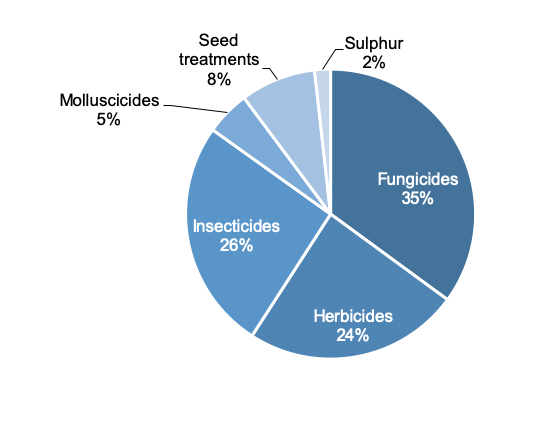
Note: growth regulators, biological control, biopesticides and physical control have been excluded as their use represents <0.5 % treated area
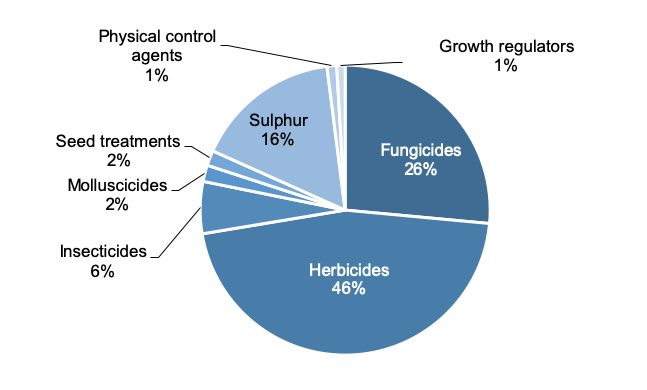
Note: invertebrate biological control agents are applied by number of organisms rather than weight therefore weight data are not presented
Insecticides accounted for 26 per cent of the total pesticide treated area and six per cent of the total weight of pesticides applied (Figures 7 & 8). There was a 13 per cent increase from 2017 to 2019 and a nine per cent decrease from 2015 to 2019 in the area treated with insecticide formulations when changes in crop area are taken into account (Figure 5). Similarly, in terms of weight applied per hectare of crop grown, there was an increase of 20 per cent from 2017 to 2019 and a decrease of 11 per cent from 2015 to 2019 (Figure 6). Pyrethroids remain the principal form of insect control employed, in terms of area treated (Table 14). However, this was the only chemical group to see a decrease in use from 2017. Use of insecticides with other modes of action (spinosad, pymetrozine, indoxacarb, spirotetramat and flonicamid) all increased. This is likely to be related to the pyrethroid resistance status of a number of target species. One noted increase is in the active substance spinosad, which is one of the few options remaining for the treatment of cabbage root fly after the application of chlorpyriphos was restricted to use in propagation areas. The control of diamondback moths was one of the reasons provided for the use of insecticides. Diamondback moths are also thought to be resistant to pyrethroid insecticides with spinosad being an alternative for their control(6).
All the leaf brassica crops, 26 per cent of other vegetables and three per cent of turnips and swedes were grown from transplants. The rest of the crops were grown directly from seed. Of these crops, vining peas had the highest proportion of treated seed with 100 per cent treated, followed by 82 per cent of carrots and 75 per cent of turnips and swedes. Seed treatments accounted for eight per cent of the total area treated and two per cent of the total weight applied (Figure 7 & 8). When changes in crop area are taken into account, there was a decrease in area treated with seed treatments of one per cent from 2017 to 2019 and a decrease of 19 per cent from 2015 to 2019 (Figure 5). The weight of seed treatment applied per hectare of crop grown decreased by two per cent from 2017 to 2019 and by nine per cent from 2015 to 2019 (Figure 6).
Molluscicides accounted for five per cent of the total pesticide treated area and two per cent of weight (Figures 7 & 8). When changes in crop area are taken into account, there was a decrease in area treated of 14 per cent between 2017 and 2019 and an increase of 18 per cent between 2015 and 2019 (Figure 5). Similarly, the weight of molluscicides applied per hectare of crop grown was lower in 2019 compared to 2017 (17 per cent less) and higher in 2019 than 2015 (ten per cent). Slug numbers are closely linked to weather conditions and fluctuate accordingly. There were reduced levels of slug activity in 2015 due to the late cold spring, whereas the wet summer in 2017 increased the risk of slug damage(3).
Sulphur applications accounted for two per cent of the total pesticide area treated and 16 per cent of total weight applied (Figures 7 & 8). Sulphur has dual use as both a fertiliser and a fungicidal treatment and is permissible in some organic systems. When area grown is accounted for, there was a 33 per cent increase in the use of sulphur between 2017 and 2019 and a nine per cent increase between 2015 and 2019 (Figure 5). The weight of sulphur applied per hectare of crop grown also increased by 71 per cent from 2017 to 2019 and by 67 per cent between 2015 and 2019 (Figure 6). Most of the sulphur use was on vining peas and other vegetable crops which have both seen increases in crop area (Table 20).
Pesticides classified as physical control represented less than 0.5 per cent of the total pesticide treated area and one per cent of the total weight of pesticides applied (Figure 7 & 8). In 2019, as in 2017, all physical control encountered was garlic based. This pesticide type was only applied to carrots as a control for free living nematodes. No physical control was encountered in 2015.
Growth regulators and biological control agents were encountered in this survey, but their use represents less than 0.5 per cent of the treated area. This is the first time the use of biological control agents have been encountered in this series of vegetable reports since the 2013 survey(7). All biological control recorded in 2019 was Phasmarhabditis hermaphrodita applied to Brussels sprouts as a treatment for slugs. No biopesticides were recorded in this survey. Growth regulators were previously encountered in the 2015 survey.
As well as changes in overall trends in application of pesticide groups since the previous survey, there has been variation in the use of individual active substances. The herbicides diflufenican, aclonifen and the insecticides flonicamid, cyantraniliprole and chlorantraniliprole were recorded for the first time on outdoor vegetable crops in this survey (Table 13). In terms of area treated, the most used active substance was the fungicide azoxystrobin, which has increased by 70 per cent since 2017 (Table 17). Other notable changes in fungicide active substance use include difenconazole which increased by 141 per cent in area treated. The herbicides prosulfocarb and bentazone have increased by 128 and 121 per cent respectively by quantity of active substance applied (Table 18).
There was a continued increase in the molluscicide ferric phosphate, repeating the trend seen in the previous two reports. The use of ferric phosphate increased by 11 per cent (area treated) and nine per cent (weight applied) (Tables 17 & 18). Whereas the use of metaldehyde decreased by 43 per cent (area treated) and 45 per cent (weight applied). We also recorded the use of Phasmarhabditis hermaphrodita to control slugs as an alternative to metaldehyde. All products containing metaldehyde formed part of an enhanced stewardship plan from 2017 reducing its usage(8). In December 2018 it was announced that the authorisation of metaldehyde containing products had been refused and that their use would be phased out. However, following a legal challenge, this decision was quashed in July 2019 and metaldehyde is currently still on the market. The reduction in use of metaldehyde and the continuing increase of ferric phosphate, may have been in preparation for the change in legislation. It should be noted that, unlike metaldehyde, there are no watercourse restrictions when using ferric phosphate.
Integrated pest management
Information about the uptake of IPM measures by Scottish growers was collected alongside the 2019 outdoor vegetable crops pesticide usage survey. This 2019 IPM survey represents the second in the series of surveys of IPM measures on vegetable crops, allowing the adoption of IPM techniques to be monitored.
This is a summary of the data; please refer to Appendix 6 for the full dataset. Growers were asked a series of questions about the IPM activities that they implemented for outdoor vegetable crop production. Unlike the other statistics in this report, the figures relating to IPM are not raised to produce national estimates but represent only the responses of those surveyed.
In total, IPM data was collected from 27 growers and grower groups, collectively representing 63 holdings and eight per cent of Scotland's 2019 outdoor vegetable crop area. Of these growers, 67 per cent had an IPM plan (33 per cent completed their own IPM plan and 33 per cent had a plan completed by their agronomist) (Figure 26). This represents a significant increase in the use of IPM plans from the 2015 survey where 36 per cent of growers completed an IPM plan. Since 2015, there has been a focus on the promotion of IPM and the introduction of mandatory completion of IPM plans within some key QA schemes to help growers make the best possible and most sustainable use of all available methods of pest control. Growers were asked about their IPM activities is relation to three categories; risk management, pest monitoring and pest control.
In both 2019 and 2015, all growers sampled reported that they implemented at least one measure associated with an IPM risk management approach (Table 32). Although not statistically significant, there were increases in uptake in some risk management activities from 2015 including soil testing (88 per cent of respondents in 2015 to 96 per cent in 2019), management of seed bed agronomy (76 per cent in 2015 to 81 per cent in 2019), use of catch or cover cropping (36 per cent in 2015 to 44 per cent in 2019) and adoption of techniques to protect or enhance populations of beneficial organisms (72 per cent in 2015 to 81 per cent in 2019).
In terms of the uptake of pest monitoring activities, there was very little change seen between 2015 and 2019 and no statistically significant differences. In both years, the majority of growers sampled (96 per cent) reported they implemented at least one pest monitoring measure (Table 33). There were some changes, however, in the methods of monitoring and identifying pests with an increase in self-inspection of crops (28 per cent in 2015 to 67 per cent in 2019), use of risk warnings, technical bulletins and press articles in 2019 (48, 44 and 22 per cent of growers respectively, Figure 34).
Ninety six per cent of the growers sampled in 2019 adopted at least one IPM pest control activity, a small decrease from 100 per cent in 2015. There were no statistically significant differences in pest control activities from 2015 to 2019. (Table 34). There was an increase in the use of non-chemical control (from 76 per cent of respondents in 2015 to 81 per cent in 2019). There were small decreases in the use of targeted pesticide applications to reduce pesticide use (76 per cent in 2015 to 70 per cent in 2019) and anti-resistance strategies (80 per cent in 2015 to 74 per cent in 2019). This may have been influenced by the increase in the proportion of organic growers from 12 per cent of respondents in 2015 to 19 per cent in 2019. Finally, there was a small decrease in the proportion of respondents who stated that they regularly monitored the success of their crop protection measures (100 per cent in 2015 to 93 per cent in 2019).
Contact
Email: psu@sasa.gov.scot
There is a problem
Thanks for your feedback